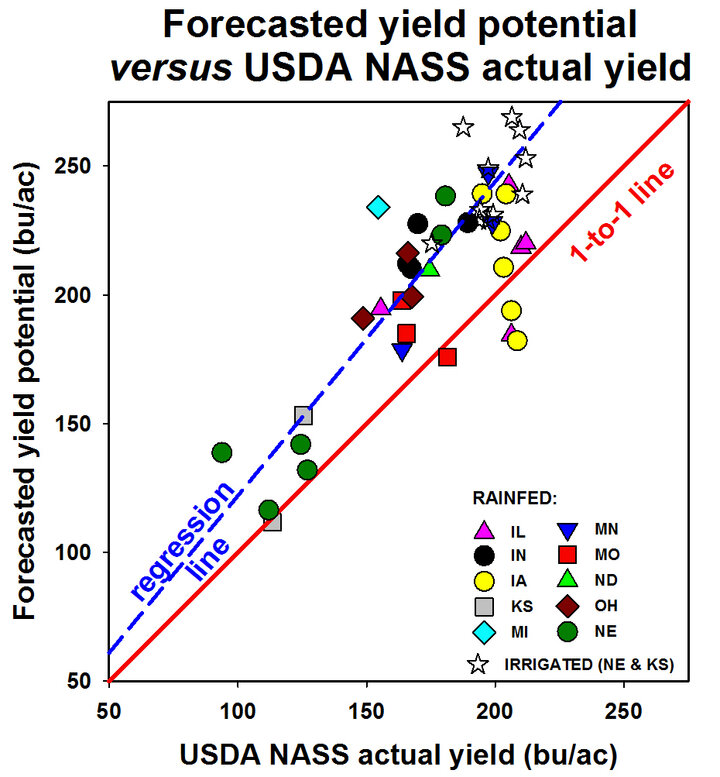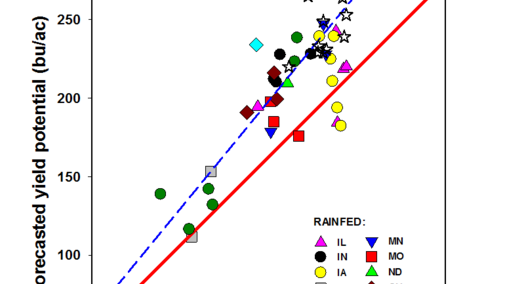Here we provide an evaluation of the corn yield forecasts released during the 2016 crop season by the Yield Forecast Center. We compared our end-of-season forecasted yield potential against the average corn yields reported by USDA NASS for rainfed and irrigated production.
Our estimates of corn yield potential were developed using the Hybrid-Maize model, local weather, and soil conditions at each location. (View details on the 2016 yield forecasts and underpinning methodology.) These estimates were compared against average corn yields retrieved from the counties that overlap with the forecasted sites. The evaluations were performed for rainfed and irrigated corn across 10 states (Illinois, Indiana, Iowa, Kansas, Michigan, Minnesota, Missouri, Nebraska, North Dakota, and Ohio).
Figure 1 summarizes the comparison between forecasted yield potential (vertical axis) and USDA NASS actual yields (horizontal axis). Except for the irrigated locations (indicated with stars), all data points correspond to rainfed sites. The 1-to-1 line is shown in red; all data points would fall on top of the red line if agreement were perfect. As expected, the majority of forecasted yield potential values are above the actual farm yield (i.e., they fall above the red line) because the model only accounts for the effects of weather and soils on yield and does not take into account other yield-limiting factors such as uneven plant stands, nutrient deficiencies, excess water and flooding, and incidence of weeds, diseases, and insect pests.
The regression line (blue dashed line) in Figure 1 indicates that the forecasted yields reflected the actual yield trend across sites. However, this was not the case for rainfed locations in Iowa, Illinois, and Missouri. Indeed, some of the actual yields reported for these sites exceeded the forecasted yield potential (i.e., they fall below the 1-to-1 line).
Examination of the simulations and consultation with local experts indicated that corn grown at these areas likely benefitted from water supplied from shallow water tables during the entire growing season. In other words, in addition to rainfall and stored soil water in the root zone at planting, these crops may have received additional water from “sub-irrigation” from a transient shallow water table. Corn in these fields likely grew without experiencing water stress even during relatively long rain-free periods. And because Hybrid-Maize does not account for the influence of a shallow water table under rainfed production conditions, the model underestimated rainfed yield potential at regional and national levels.

To summarize, our evaluation indicates that the forecasts were able to capture the spatial pattern in dryland and irrigated corn yields across the US Corn Belt. However, the evaluation also indicates that forecasted rainfed yields were underestimated at sites where there was a shallow water table during the crop growing season, and especially during the critical silking and pollen shed period. This was the case in many regions in the central and eastern Corn Belt in 2016.
In contrast, the 2016 yield forecasts for irrigated and rainfed fields without a shallow water table were once again robust. Because reproducing the influence of water table on yield is difficult in this simulation and there is high uncertainty as to the spatial distribution of the water table and its dynamics during the growing season, our 2017 yield forecasts will not include areas of the Corn Belt where the shallow water table influences corn yields. We will continue to provide in-season yield forecasts for all major irrigated corn-growing regions.

